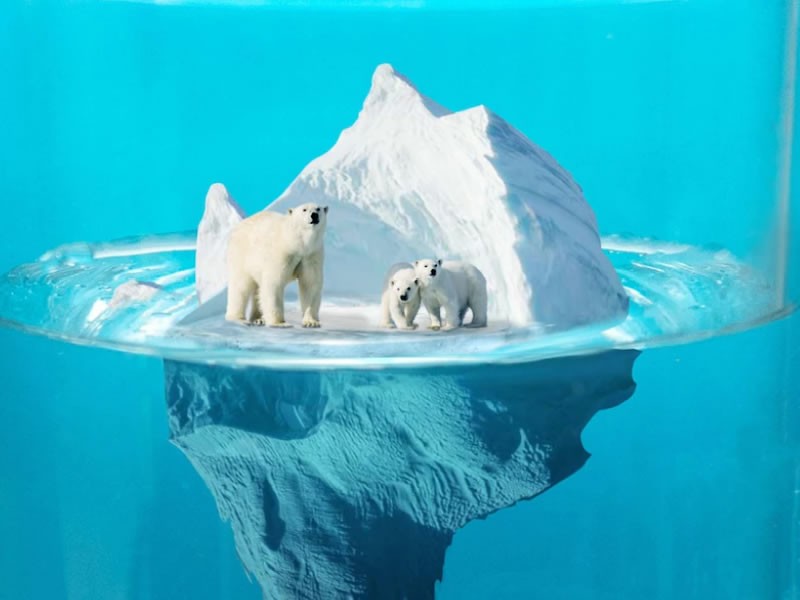Insight Blog
Agility’s perspectives on transforming the employee's experience throughout remote transformation using connected enterprise tools.
8 minutes reading time
(1617 words)
Iceberg Model of Culture – UPDATED 2022 – A Complete Guide
Like an iceberg, the visible part of culture is only a small part of a much larger whole. Let's dig a bit deeper into the concept of the Iceberg Model of Culture.
A cultural iceberg is a common metaphor. As an iceberg has two sections; a visible (cultural aspects we are aware of) and a larger, unseen (cultural aspects we are unaware of) section.
So, culture can be described as having some aspects that are conscious (observable elements of culture that we are aware of) and others that can only be suspected, imagined, or intuited (elements of culture that we are less conscious about).
Similarly, the conscious parts only reflect a small portion of the culture, and only by going deeper and grasping the elements below the surface can a more complete picture of culture be produced.
Moreover, the iceberg/onion model should be taken into account while discussing behavior, beliefs, values, and norms, as well as mental patterns.
Iceberg Model of Culture:
"Iceberg Model of Culture," established by Edward T Hall in 1976, describes how organizational culture is like an iceberg found in the cold waters of the Arctic.
Only 10% of an iceberg is visible above water, while the rest is submerged under it; this is known as the "iceberg effect."
As with an iceberg, the actual visibility of organizational culture is disproportionate to its size and importance.
In contrast to the "surface culture," the foundation of a strong culture is often immersed in the values and beliefs of the organization, called the underlying "deeper culture," which is often invisible to the outside world.
When it comes to culture, it's not just about what people wear or how they conduct themselves in the workplace; it's about what they believe and how they treat others.
Why the iceberg analogy is a good one?
A little fraction of an iceberg's mass can be seen as it rises out of the sea.
As with clothes, look, speech, grooming, greeting customs, and music or art, people only perceive a small fraction of someone's culture at first.
These observations, however, only represent a small part of a person's total cultural makeup. A cultural iceberg, like a real iceberg, has fundamental features that lie just below the waves.
Define core values
The cultural iceberg has a lot of crucial components that are hidden beneath the surface. These include one's own thoughts, preferences, and priorities, which make up one's attitude and values.
In a culture's basic values, there is an awareness of what is morally acceptable vs morally unacceptable. Individuals in the culture have also been taught about acceptable and improper behavior.
The importance of honesty, respect, and integrity are taught to children and adults through core values. However, these values may be proclaimed or interpreted in a variety of ways in different contexts.
How core values are being interpreted?
The perception of essential values is buried deeper in the cultural iceberg than you may think.
Observable behaviors, such as which words people use to talk, the tone of voice they use, the laws that are passed, and the mannerisms they employ while dealing with other people, can be used to better understand and interpret these behaviors.
Other people make inferences about core principles based on how they conduct themselves in the workplace.
Making changes to core values
Despite the fact that many people learn about core values as part of their upbringing, these beliefs might shift with time.
A person's underlying values may change as a result of new experiences and cultural transformations.
However, these modifications are not always simple or quick to implement. The culture's exterior image includes several key values.
Individuals that are a member of the culture continue to be influenced by the values that have been passed down through the generations.
Individuals may be guided, taught, and influenced by the essential values. Besides what people learn at home and in school, additional cultural influences include what they see and hear in the media and the laws that are established.
These things have an impact on social norms and the way people think about the world and what's important to them.
Studying the cultural iceberg
There are some features of culture that can be observed by the naked eye.
There are several ways in which they might gain a deeper grasp of deeply ingrained concepts by studying formative influences such as cultural values, self-reflecting on core values, and examining those values in others.
They can also be receptive to the idea that people's values may vary.
Iceberg model of culture examples:
There are both visible and unseen aspects to organizational cultures.
Public awareness of an organization's principles and activities is a given. Organizations, like icebergs, are propelled by behaviors that aren't always obvious, so leaders must look beyond things like high employee turnover and a lack of employee engagement.
Employees' resistance to change or a disconnect between a company's culture and strategy must be investigated further.
Visible aspects
Begin by focusing on events or visible cultural practices while using the Iceberg Model.
When someone from one culture travels to another, they may experience cultural shock due to the differences in how people dress, eat, live, and greet one another. A deeper knowledge of individuals and their behavior can be gained by learning about cultural differences.
Thoughts and concepts
The truth is, we all think some things about ourselves that we know aren't true. It doesn't matter if these views are about yourself or the world at large. Stress, anxiety, and frustration are all possible side effects.
Employee habits and patterns
People's actions tend to follow a set pattern, according to the Iceberg Model of Cultural Identity. The ability to see patterns can make it easier to work together or bring about a shift in the status quo.
As an illustration, a company's employees are consistently running late, and the team leader is baffled as to why this is happening. Only by digging deeper does she discover a pattern: every day, they had a late-night meeting that frequently lasted longer than the authorized hour. So the following day, they were late to work.
The team leader was able to find the source of the problem by looking for patterns in the data. She changed the time of the daily meeting to be earlier in the morning so that everyone could leave work on time.
Culture as an iceberg theory
How is it possible that a culture can be compared to an iceberg? Maybe it's because people like to learn about other cultures.
- Maybe it's because of the way culture may sometimes feel like it's lost in the midst of a sea of human emotions? Is it because the Titanic of culture has sunk?
- That is not true. As far as visibility is concerned, the two are very similar: Icebergs are known to be disproportionately large. You can see 10% of its surface, yet 90% of its mass is hidden beneath the surface.
- There is a lot in common between us. When it comes to comprehending culture, you can only see approximately 10% of it, but to truly grasp the rest, you must delve deeper. Anthropologist Edward T. Hall, who helped establish many of the current conceptions of culture, came up with the concept in the 1970s. Our understanding of human civilization has been greatly enhanced by Hall's paradigm.
Difference between visible & invisible culture iceberg
The tip of the cultural iceberg, or the top ten percent, is a good place to start. As soon as you encounter a new culture, whether it be through travel or other means, this is the first aspect of that culture you notice.
- These are all the senses you have access to. Food, music, visual art, language, celebrations, and games are all included.
- These details are crucial. When it comes to the way cultures communicate and retain their sense of oneness, visible cultural characteristics play a critical role. They are, nevertheless, prone to change. Everything from recipes to games to art has the potential to evolve through time.
- Even the way we speak changes with time. This means that cultural aspects of 10% of culture are less emotionally taxing than other parts of 10% of culture. Despite the fact that they are important to people, they may also be modified and adjusted without fundamentally altering a culture or people's notions about who they are.
Invisible aspects of culture
Cultural aspects that aren't explicitly stated but remain a part of the culture are known as invisible aspects of culture. For example, nonverbal communication, how we express or engage with our emotions as well as ideas about personal space, attractiveness, and fundamental manners and behavior are all part of this.
- An outsider has a harder difficulty comprehending this area of society because it isn't as readily apparent. It's also more emotionally taxing. Changes in these values cause people to fear for their sense of cultural identity.
Try for 14 days free
Categories
Blog
(2618)
Business Management
(320)
Employee Engagement
(210)
Digital Transformation
(174)
Growth
(119)
Intranets
(119)
Remote Work
(61)
Sales
(48)
Collaboration
(37)
Culture
(29)
Project management
(29)
Customer Experience
(26)
Knowledge Management
(21)
Leadership
(20)
Comparisons
(6)
News
(1)
Ready to learn more? 👍
One platform to optimize, manage and track all of your teams. Your new digital workplace is a click away. 🚀
Free for 14 days, no credit card required.


















